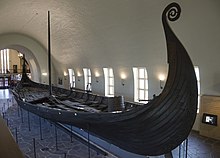


The Oseberg ship (Norwegian: Osebergskipet) is a well-preserved Viking ship discovered in a large burial mound at the Oseberg farm near Tønsberg in Vestfold county, Norway. This ship is commonly acknowledged to be among the finest artifacts to have survived from the Viking Age. The ship and some of its contents are displayed at the Viking Ship Museum at Bygdøy on the western side of Oslo, Norway.[1]
Excavation of the ship from the Oseberg burial mound (Norwegian: Oseberghaugen ved Slagen from the Old Norse word haugr meaning kurgan mound or barrow) was undertaken by Swedish archaeologist Gabriel Gustafson and Norwegian archaeologist Haakon Shetelig in 1904–1905.[2] The grave also contained two female human skeletons as well as a considerable number of grave goods. Scientific dating of the ship suggests it was buried no earlier than 834, although certain parts of its structure date from as early as 800, while other parts may be even older.[1]